The post What you need to know from Google Marketing Live appeared first on MarTech.
]]>Performance Max upgrades. Google is helping more advertisers try their most automated campaign type, Performance Max. These enhancements include:
- In-store goals
- Burst campaigns for seasonal foot traffic
- ‘Experiment tools’ to help test potential lift
- More insights
- Support for Search 360 and the Google Ads app
- Optimization score recommendations
- Read more: 6 updates coming to Google Performance Max campaigns
YouTube Shorts ads. Those advertisers currently running video action campaigns and app campaigns will have ads automatically scale to fit Google’s TikTok competitor, YouTube shorts.

Shorts are limited to one minute in length and advertisers may want to tighten up and hone in creative, given the timeframe. This will be rolling out now to advertisers globally, so make sure to measure results and annotate accordingly.
Swipable shopping ads in search. A big, bold new ad display pairs organic shopping results with shopping ads for a highly visual shopping experience. This is for apparel brands only and will be available through Search and Performance Max campaigns.
Dig deeper: Google is giving users greater control over what ads they see
Product feeds for a shoppable YouTube experience. Later this year, advertisers will have the ability to connect product feeds to campaigns to create shoppable video ads on YouTube Shorts. Google said they have been experimenting with ads in YouTube Shorts since last year and are now slowing rolling out to advertisers across the globe.
Google said this is a “key step on our road to developing a long-term Shorts monetization solution for our creators, which we’ll share more about soon.” Beyond that, no additional context on this interesting marriage of the feed and Shorts was provided.
Coming soon to search results: 3D models of products. According to Google, “Augmented reality (AR) on cameras gets us close, and shoppers are ready for it. More than 90% of Americans currently use, or would consider using, AR for shopping.”
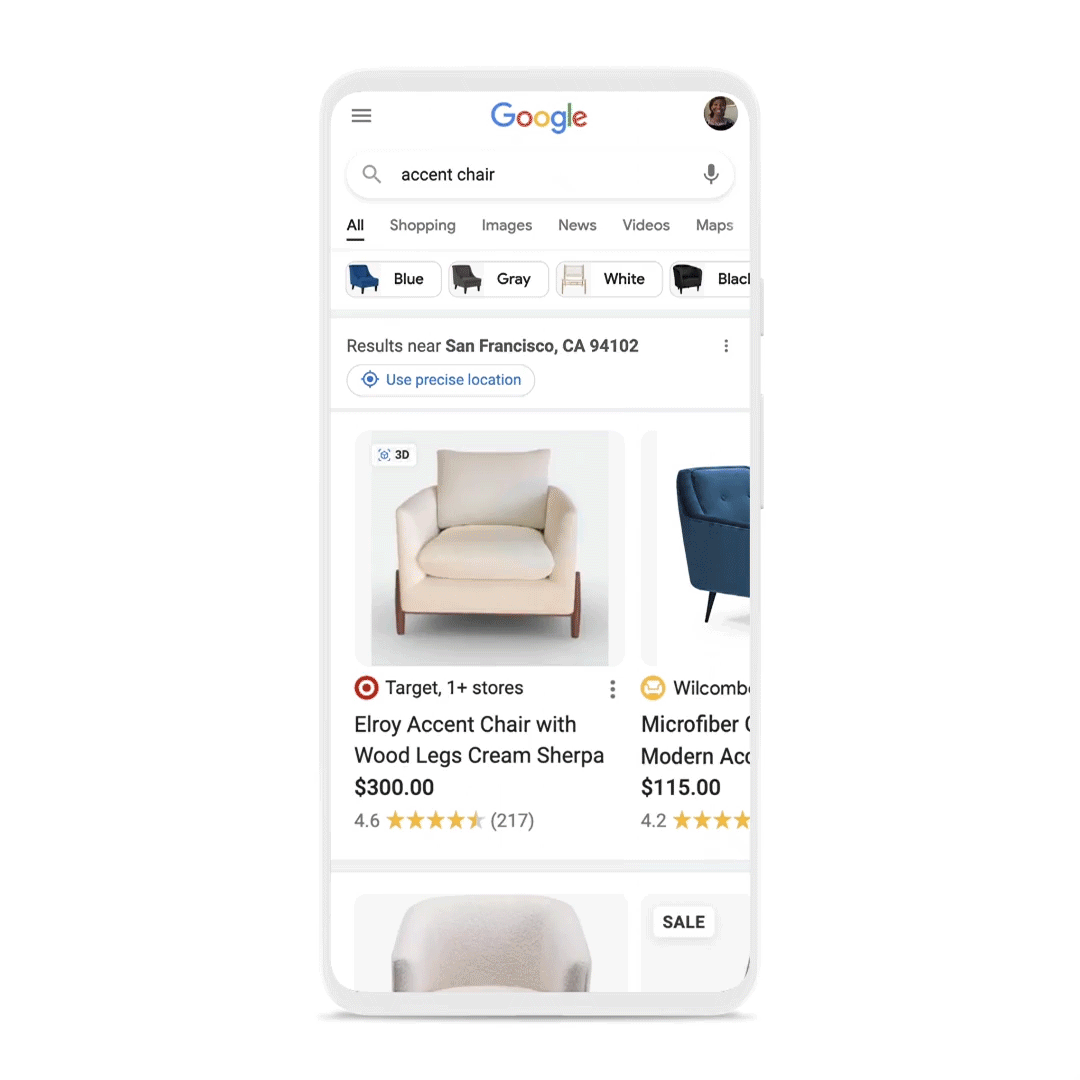
Merchants will “soon” have the ability to have 3D models of their products appear directly within the search engine results pages. No additional details on the program have been released.
Insights page updates. The Insights page is getting a major overhaul, with a focus on attribution and first-party data.
A new attribution section will show advertisers a better view of what drove conversions within accounts.
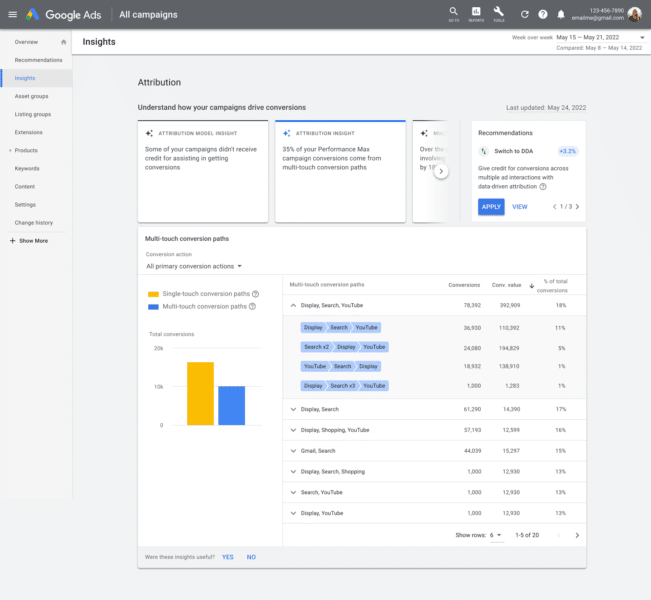
This will also recommend a better attribution model if Google detects it can provide a better view on conversions.
The last new insight is the support of first-party data. The insights page will help advertisers view which customer lists are driving performance for campaigns – with privacy at the forefront.
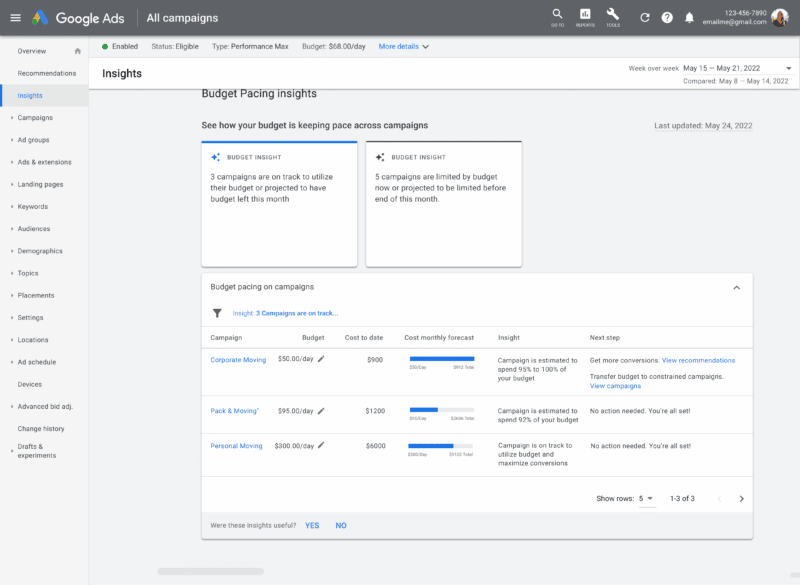
According to Google, new budget insights may help to identify opportunities to optimize ad spends. This feature will show how spend is pacing against performance.
The implementation and rollout will be interesting to observe, but much like Google’s recommendations, this should only be one piece of the decision-making puzzle.
Loyalty program ads integration. Advertisers using Performance Max along with a product feed will be able to drive more loyalty sign-ups across YouTube, Display, Search, Discover, Gmail and Maps, Google announced.
While this sounds interesting on paper, there will be a lot to unpack in the execution of this program. Advertisers with shopping feeds generally look to drive revenue from ads, not sign-ups.
The details are fuzzy at this point, but Google said more updates are coming in the second half of 2022. This is slated for the U.S. only.
Video ads in Discover
A big addition for video advertisers is the announcement of video ads showing directly in Discover. This is a great fit as Discover currently features many videos in the feed currently.
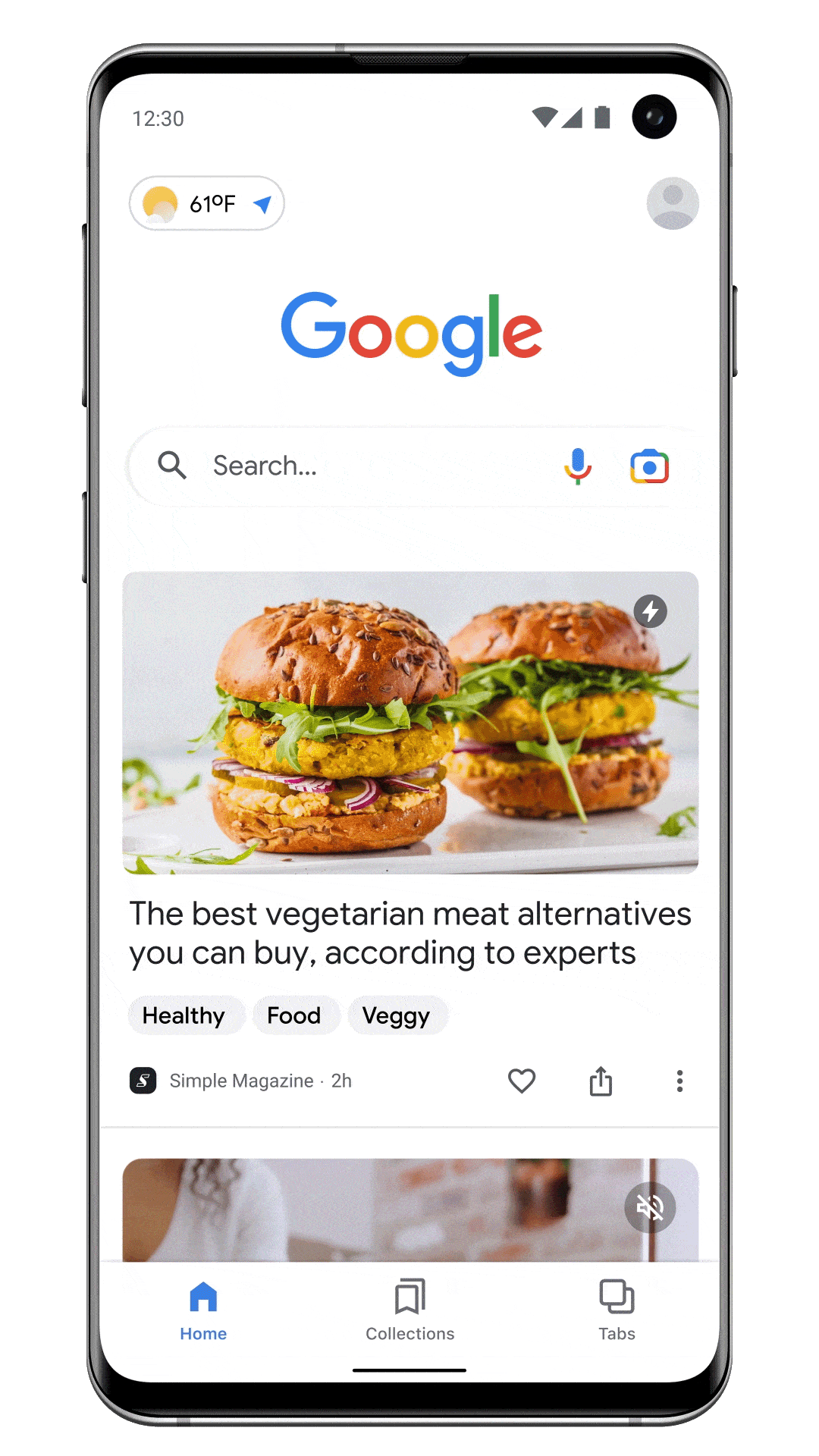
Discover ads work well with bold, eye catching images currently and video should be no different.
Google Audiences for Connected TVs. Advertisers will soon be able to use connected TV campaigns to target viewers across YouTube and “most” other connected TV apps. This exciting new development will bring affinity, in-market, and demographic audience segments to connected TVs.

The affinity audiences are available in a global beta. The in-marketing and demographic audiences will be in beta for global advertisers at the end of Q2.
Checkout on Merchant. Google will be streamlining checkouts for customers that “have decided what they want.”
With this implementation customers won’t need to go through so many screens/pages in order to checkout and will instead be sent directly to the existing buy-flow from the merchant – directly from the product listing. According to Google, Merchants will “own the customer” as the transaction happens directly in their flow.
While an interesting concept, this direct purchase may see a decline in AOV (average order value) as users won’t browse the site and will instead click the product listing and directly purchase. This is currently a closed pilot and Google is working to expand and move towards general availability in the coming months.
Asset Library availability for all advertisers
A nice new feature announced will help advertisers leverage current ads and assets outside of Google. According to Google it will be a “one-stop-shop” for asset collaboration and storage for images and video content.

These assets can be accessed once imported from Discovery, App and Performance Max campaigns with plans for YouTube and shopping “coming soon.”
YouTube video creation in 60 seconds
No video ads? No problem. From within the Asset Library, Google announced that advertisers can create a video ad and publish to YouTube in as little as 60 seconds. This can be done with as few as 5 images, logos and text assets with the outcome being “an effective ad”.

Advertisers that have seen the auto-generated Performance Max campaigns haven’t been overly pleased with videos that have been created, so make sure to proof the output if you use this feature.
Enhanced Conversions for additional channels
A new Enhanced Conversions for Leads is a privacy safe connection between leads and funnel progression by way of offline conversion imports. A new Lead Funnel report will be coming to Google Ads later in the year to help visualize lead progression.

A beta of Enhanced Conversions for website conversions will be opening for Search Ads 360 and if you use 3rd parties to manage campaigns like Tealium, Segment, mParticle and Adobe may already feature Enhanced Conversions.
Why we care. Some of the items released (e.g., Checkout on Merchant and swipeable shopping ads) may have a major impact on advertisers, while other features (like the Performance Max experiment tools and Shorts expansion) may not.
Like every year, with many of the new features the devil will be in the details but the additional insights, and targeting should shake out to be an upgrade for advertisers across the globe.
The post What you need to know from Google Marketing Live appeared first on MarTech.
]]>The post Google is giving users greater control over what ads they see appeared first on MarTech.
]]>My Ad Center is supposed to let users like, share or block any ad across selected Google properties. They’ll also be able to find out who paid for the ad, and why they, specifically, were targeted with it.
Google users will be able to dictate:
- Which brands and topics they like.
- The amount of personalization they are comfortable with for their ad customization.
These personalization options can be accessed from My Ad Center or within the ad itself.
If consumers use it, My Ad Center will give Google ad data. In exchange users will get more control over ads on Google properties including YouTube, Discover and Search. With third-party data going away, the ability to follow brands will provide critical feedback directly to Google.

Ever wonder how frequently marketing software is replaced?
Here’s the answer.
Download the 2022 MarTech Replacement Survey!
What we know about My Ads Center right now:
Follow brands and topics. All Google users will now have the ability to choose the brands and topics most germane to them that they want to see. This is much different than the Topics targeting within the Privacy Sandbox now being tested, as the inputs are dictated directly by the user.
An example provided by Google was that a user interested in a hybrid car may choose this as a topic they’d be interested in and would be served ads related to that particular topic. This can also work with specific brands they like.
Personalization and data source controls. My Ad Center is designed to provide a single place where users can limit any/all information used for ad personalization, including age, relationship status, education and demographic data. Users can also limit or opt-out of sensitive ad topics (e.g., gambling, alcohol, dating, weight loss, and pregnancy & parenting).
It also gives consumers control over the data sources used. Users will be able to choose which data sources can be used to personalize ads and which sources should be used across some Google properties (e.g., personalized search, YouTube recommendations).
Expanded controls within ads. While My Ad Center is nice, let’s be honest, sometimes people just want to make changes immediately when they see an ad. Those folks are in luck. They will be able to make changes or get targeting clarity directly within the ad. The new controls will allow users to like, block or report an ad, while also being able to tune the targeting if they’d like to see more or less of the brand or topic shown.
However, the biggest change for advertisers may be the transparency features included directly within the ad controls. The “About this ad” is being replaced with the new transparency features that show who paid for the ad (using Advertiser Identity Verification) and the account categories used to show the specific ad. This is very different from the “Why this ad” feature. It displayed matching criteria but not who paid for it.
Not all of Google. At launch My Ad Center will only work for Google search, YouTube and Google Discover and not for the Google Display Network, Gmail or Search Partners (yet). There is also expected to be a second ad settings page, separate from My Ads Center, for sites that partner with Off-Google ads (ie the Google Display Network).
The topics or brand updates inputted into the My Ads Center won’t initially be passed to this new second ad settings page. However, if ad personalization is shut off entirely within My Ads Center that will shut off all personalization across all Google-owned and non-Google-owned properties.
Why we care: This is potentially a win/win for marketers and consumers, as well as a big step up on privacy by Google. The brands and topics to follow could provide marketers with a lot of data about people interested in their products. Interested users will have easy access to who is paying for an ad and why they were targeted (which will also be of interest to competing marketers). They will also have a simple way to shut off ad targeting on Google and many non-Google sites. It will be fascinating to see how many people actually use it when it becomes available.
Dig deeper: 3 challenges of building customer trust in a privacy-focused world
The post Google is giving users greater control over what ads they see appeared first on MarTech.
]]>The post What marketers need to know about Facebook’s updated Business Tools Terms appeared first on MarTech.
]]>
As Facebook CEO Mark Zuckerberg faced Senate and House committees in Washington, DC, this week, the platform introduced new terms around the use of customer data, tracking and measurement. Zuckerberg reiterated to lawmakers that Facebook will, in effect, apply the EU’s General Data Protection Regulation (GDPR) standards to its business globally. Not surprisingly, the Terms changes are timed to go into effect on May 25, 2018, the same date the GDPR’s sweeping set of rules governing the handling of consumer data will go into effect.
A new “Facebook Business Tools Terms” consolidates the “Conversion Tracking, Custom Audiences From Your Website, and Custom Audiences From Your Mobile App Terms” and “Offline Conversion Terms,” and the Custom Audience Terms have been updated. Here’s a rundown of the key changes to the terms that apply to any website owner, publisher, developer, advertiser, business partner (and their customers) and any other entity that integrates with, uses and exchanges information with Facebook. Note that Facebook Business Tools encompass a lot: APIs and SDKs, the Facebook Pixel, social plugins such as the Like and Share buttons, Facebook Login and Account Kit, as well as other platform integrations, plugins, code, specifications, documentation, technology and services.
New terms for GDPR compliance
In section 5.1 of the Facebook Business Tools Terms, a note to EU and Swiss data controllers specifically on GDPR states:
To the extent the Customer Data contain personal data which you process subject to the General Data Protection Regulation (Regulation (EU) 2016/679) (the “GDPR”), the parties acknowledge and agree that for purposes of providing matching, measurement, and analytics services described in Paragraphs 2.1 and 2.2 above, that you are the data controller in respect of such personal data, and you have instructed Facebook Ireland Limited to process such personal data on your behalf as your data processor pursuant to these terms and Facebook’s Data Processing Terms, which are incorporated herein by reference. “Personal data,” “data controller,” and “data processor” in this paragraph have the meanings set out in the Data Processing Terms.
What this means: This section clarifies that the Facebook Marketers are considered data controllers from a GDPR standpoint and Facebook the data processor. A third-party data processor is an entity that processes personally identifiable information (PII) on behalf of a controller. A controller is defined by the GDPR as an entity that determines how that data will be processed and for what reason. Both controllers and processors must comply with the EU regulation.
The Terms for using Facebook Pixels and SDKs have also been updated for GDPR. Section 3.3 states:
In jurisdictions that require informed consent for the storing and accessing of cookies or other information on an end user’s device (such as but not limited to the European Union), you must ensure, in a verifiable manner, that an end user provides the necessary consent before you use Facebook Business Tools to enable us to store and access cookies or other information on the end user’s device. (For suggestions on implementing consent mechanisms, visit Facebook’s Cookie Consent Guide for Sites and Apps.)
What this means: Site and app owners must obtain and manage user consent for Facebook to access, gather and store their data. This is a critical piece of GDPR that pertains to any company controlling or processing data on EU citizens, regardless of where they reside.
Requirement to notify Facebook of any actual or ‘threatened’ complaints about personal data
Another important change in the terms that marketers need to be aware of is in section 1.5. The provision states:
You will notify us promptly in writing of any actual or threatened complaint or challenge related to the use of personal data under these Business Tools Terms and will cooperate with us in responding to such complaint or challenge.
What this means: Advertisers must take any user’s complaint (even threatened) about the use of personal data seriously. You must be prepared to report to Facebook, in writing, any suggestion of a complaint or challenge over the handling or use of personal data when you’re made aware of it.
Keep reporting internal
Want to share a case study about your Facebook ad campaign? Think again. Section 2.2.2 of the Facebook Business Tools Terms explicitly states that advertisers are not allowed to share Campaign Reports or Analytics unless they have Facebook’s written consent:
We grant to you a non-exclusive and non-transferable license to use the Campaign Reports and Analytics for your internal business purposes only and solely on an aggregated and anonymous basis for measurement purposes. You will not disclose the Campaign Reports or Analytics, or any portion thereof, to any third party, unless otherwise agreed to in writing by us. We will not disclose the Campaign Reports or Analytics, or any portion thereof, to any third party without your permission, unless (i) they have been combined with Campaigns Reports and Analytics from numerous other third parties and (ii) your identifying information is removed from the combined Campaign Reports and Analytics.
What this means: All Campaign Reports and Analytics need to stay internal and include only anonymized, aggregated data. Keep screen shots and charts out of presentations, case studies and social media unless you have permission from Facebook. However, Facebook retains the right to use your unidentified reporting data when aggregated with that of other advertisers
No pixel sharing
This is a change. Section 3.1 of the Facebook Business Tools Terms states:
You (or partners acting on your behalf) may not place pixels associated with your business manager or ad account on websites that you do not own without our written permission
What this means: You may not gather data for ad targeting or measurement by placing your or your clients’ pixels on other sites you may have access to or any other site unless Facebook OKs it. This has been a not-so-secret Facebook marketing tactic for some time. If you currently have pixels on other sites, it’s time to revisit those placements and either get Facebook’s permission or remove them to stay in compliance with the Terms.
Facebook Business Tools Terms
Some of the terminology has also changed with this update. As of May 25, 2018:
- “Sales Data” now is called “Customer Data.”
- “User Information” now means “Contact Information.”
- “Sales Transaction Data” now is “Event Data.”
- “Matched Data” now means Event Data that is combined with Matched User IDs.
- “Unmatched Data” now means Event Data that is not combined with Matched User IDs.
- “Reports” is now “Campaign Reports.”
- “OC” is now referred to as “Offline Conversions.”
Those are the main takeaways that we pulled from the updated terms. There are other changes, but they don’t appear to impact the day-to-day of marketers as much as the above. If you have any other items that stood out, please let us know on social media.
Important note: I am not a lawyer. This article is meant to uncover various changes from the perspective of a marketer. Please take the time to read through the updated product terms for yourself.
The post What marketers need to know about Facebook’s updated Business Tools Terms appeared first on MarTech.
]]>The post Instagram makes Stories advertising easier with automatic full-screen support appeared first on MarTech.
]]>
Over the years, Instagram has grown to be much more than just 1:1 aspect ratio content. The evolution moved from square to landscape and portrait content, and now full screen Stories. This has put a burden on Instagram advertisers. Multiple creatives were needed to run ads across different formats… until today.
Instagram has announced that when an advertiser uploads creative that is square or landscape, Instagram will automatically transform it to fit full screen.
This change will apply to any creative that is either a single photo or a video that is under 15 seconds (and adheres to the Instagram Feed aspect ratios). The text from the Instagram feed will be added underneath the image if the creative is square or landscape like so:


If the image is taller than a square, no ad text will show. Furthermore, Instagram will use pixel matching technology to make the experience seem more native–matching the added content colors to look more intentional. The swipe up functionality will be supported as well to allow an advertiser to include a relevant link.
This change should help to lure more advertisers into testing Instagram Stories advertising by eliminating the need for manual ad creation. Knowing that most Facebook advertisers live outside of the full-screen vertical space, it should help ease the pain for their foray into Instagram Stories.
The post Instagram makes Stories advertising easier with automatic full-screen support appeared first on MarTech.
]]>The post Facebook’s local news prioritization in News Feed now rolling out globally appeared first on MarTech.
]]>
In January, Facebook committed to surfacing more localized news within the News Feed. This announcement came on the heels of a major News Feed update that cut organic reach to commercial Facebook pages. This local news prioritization update has now been rolled out to Facebook users in all countries, across all languages.
While the social media behemoth clearly wants to surface meaningful communication between users, it is also showing a strong commitment to delivering local content. With the announcement of a localized “Today In” Hub for town hall-type content, as well as this new commitment to local news across the globe, local publishers have reason to be somewhat bullish on Facebook.
This update also includes help for those local publishers with multiple locations. Facebook will now consider a publisher as local to multiple cities if the people in those cities are more likely than the people outside of those cities to read articles from the publisher’s domain. Simply put, if a publication is consumed more by users in a specific location, it may be considered local, thereby garnering a boost in organic reach.
“By expanding the scope of what may be considered local to people, we’re including other cities that people may care about and connecting people to local publishers from those cities,” wrote Alex Hardiman, Head of News Product, and Campbell Brown, Head of News Partnerships in the announcement. Hardiman and Brown also said Facebook would ”continue to prioritize high quality news in News Feed, including news from sources that are broadly trusted, informative and relevant to local communities.”
The move to prioritize quality local news comes at a time when Facebook is struggling to regain trust among its many stakeholders for its role in enabling the spread of fake news and handling of consumer data.
The post Facebook’s local news prioritization in News Feed now rolling out globally appeared first on MarTech.
]]>The post Report shows Snapchat’s newer features falling flat but messaging more popular than ever appeared first on MarTech.
]]>
Snapchat rose to popularity thanks to the secretive nature of its photo messaging, and it has kept that theme constant when providing usage details of the app. However, The Daily Beast has uncovered recent app stats not shared publicly before. They show that some newer initiatives haven’t taken off as Snapchat’s parent company, Snap, had hoped.
The data provided to The Daily Beast spans from April to late September 2017 and includes usage metrics for Snap Maps, Discover, Memories, Geofilters, Lenses, Chat, Audio and Stories. Snap has kept these usage numbers close to the vest, only reporting on more generalized Daily Average Users (DAUs) in its earnings reports.
This summer, Snapchat launched Snap Maps, which allows users to follow and report Stories by location, find friends and more. The numbers show a steep drop and a gradual decline heading into the fall. The usage of Snap Maps peaked at 35 million unique daily users in June and dropped roughly 40 percent by September.
Yet, while Snap Maps may not be a hit the number daily Snaps sent by users has climbed steadily, as users primarily gravitate to Snapchat as a direct messaging platform. In mid-September, as many as 87 million daily unique users were sending Snaps. The chart below shows a 10 percent increase in Snaps sent since June (roughly 79.5 million daily unique users).
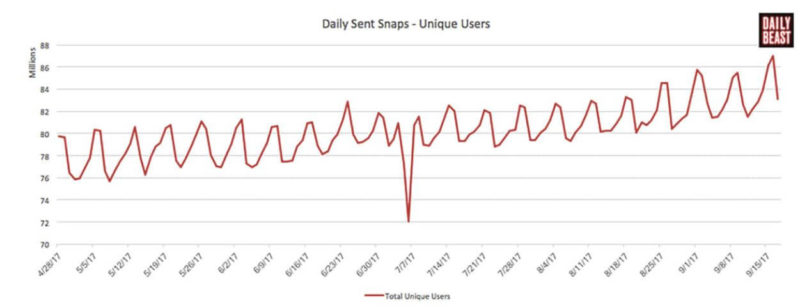
Image Courtesy of The Daily Beast
Snapchat may have pioneered Stories, but users are primarily still “Snapping”. The report highlights that Snap’s strength lies in the messaging sector, “In August, users were 64 percent more likely to send a snap to a friend than post to Stories and sent an average of 34 chat messages per day.”
Other information in the report shows minimal growth across the Discover platform, a feature that investors are keeping a close eye on. A new Snapchat design is looming with plans to split Discover from of the friends feed. A drop in Discover usage could hurt ad exposure and therefore ad revenue for Snap. Overall, fewer than 21 percent of Snapchat daily users view Discover content, with its usage peaking on July 24, according to the data provided to Daily Beast.
Snap may be hoping that the inclusion of featured stories by verified account holders, such as celebrities, in the new version of the Discover tab and a new algorithm designed to surface content likely to pique user interest will help lure more eyeballs in that direction.
For more (and very interesting comments on the secrecy of the company), see the full article on The Daily Beast.
The post Report shows Snapchat’s newer features falling flat but messaging more popular than ever appeared first on MarTech.
]]>The post Twitter announces what’s ‘Happening Now’ for sporting events, and plans for a bookmarking feature appeared first on MarTech.
]]>
Two helpful new features are making their way to a Twitter feed near you. One will help with cornering the real-time market, and the other will help with the overall user experience.
“Happening Now” is launching with sporting events and will make it easier to find tweets about events happening in real time. Bookmarking, also dubbed Save For Later, has been announced and planned, but it hasn’t been rolled out to the masses.
Happening Now
Twitter Moments were met with mixed reviews, but they truly are an important element for the social network for less regular users. Twitter is hands-down the go-to source for real-time, and tying Tweets to a source/event is where Twitter really shines. With “Happening Now,” Twitter will be pulling in current hot topics — at the top of the news feed. Hardcore Twitter users may find this excessive, but it does make sense. There isn’t a better source for live data, and a more casual user may well embrace the change. The end result (shown below) is a hybrid of Moments and Twitter search, all rolled into one:
Feel the roar of the crowd, no matter where you are.
We're rolling out a new way to see what's happening now, starting with sports in ??! Available on Android and iOS starting today. https://t.co/lmBFCK4DG0 pic.twitter.com/cv4wL8hCxA
— Twitter (@Twitter) October 10, 2017
Bookmarking
This addition is long overdue. Not everything is as black-and-white as a retweet or a like. What if you simply are interested in a topic, but you don’t have time to consume it at the moment? In the modern ecosystem, you’d either have to like it as a way to bookmark it in your likes or bookmark with your browser or extension/plugin and circle back. With the new feature, you’ll be able to bookmark directly in the Twitter environment:
For Hack Week @Twitter we started developing #SaveForLater. Here’s the early prototype that we put together in a week, which is likely to change. pic.twitter.com/c5LekvVF3l
— jesar ? (@jesarshah) October 9, 2017
This feature is still being built out while the design is being “dialed in,” but it is coming soon.
For more information, see Tweets from Twitter’s VP of Product and Twitter’s Help Center.
The post Twitter announces what’s ‘Happening Now’ for sporting events, and plans for a bookmarking feature appeared first on MarTech.
]]>The post Snapchat launches Advanced Mode for its self-serve Ads Manager appeared first on MarTech.
]]>
It’s no secret that Snap Inc has struggled in the eyes of investors since their IPO earlier this year. While the stock price has dropped, Snapchat’s Ad features and functionality have seen major upgrades. On Friday, Snapchat announced a new Advanced Mode for Ad Manager that looks to mimic Facebook’s Power Editor quite closely.

The new tool helps to automate time-intensive tasks, with a goal of helping advertisers scale their efforts. This includes:
- Bulk campaign & ad set creation
Advertisers will be able to instantly create campaigns, ad sets and ads by using a spreadsheet and importing directly into Ads Manager. - Audience library
Now Snapchat audience lists can be created and saved. This will be a boon for marketers, as it will significantly cut down on future setup efforts. - Media library
A library now exists where advertisers can store videos, images and ads for quick use on future campaigns. - Automatic ad permutation testing
This tool allows for the creation of hundreds of permutations of ad creative and custom audience variations. - Better reporting
Now reports have in-table pivoting across all dimensions and the ability to customize exports.
This is a big step up for Snapchat, as (much like Facebook’s Power Editor) it takes their ad platform to the next level from an ease-of-use standpoint and away from manual effort. With the release of Snap Publisher last month, Snapchat is pushing their platform ahead at full speed.
Advanced Mode is active for select advertisers and will have a wider release this month. To enable Advance Mode, simply click on Advanced inside Ads Manager.
For more information, see the official blog post from Snapchat.
The post Snapchat launches Advanced Mode for its self-serve Ads Manager appeared first on MarTech.
]]>The post Facebook brings value metrics to campaigns to help advertisers target the best customers appeared first on MarTech.
]]>
One of the most important dances that digital advertisers perform is the maximization of revenue on a minimal budget. It is quite remedial, really; the goal is to optimize the value of campaigns. Well, now Facebook can help you with that. Two new features have been launched by Facebook: Value Optimization targeting and value-based Lookalike Audiences.
Instead of relying on conversions, clicks, impressions or installs to power Facebook campaigns, advertisers can now target by value. This targeting is made possible by the Facebook pixel and the purchase values that are sent back to Facebook. Facebook will then take that data and estimate just how much a person may spend with you over a seven-day period. This new targeting will then adjust your bid automatically to cater to these more valuable folks. This adds a layer of clarity above traditional conversion targeting, as the end goal is revenue, not just transactions.
Value Optimization is beginning to roll out today and will be seen for eligible businesses over the next few months. Value optimization is accessible within website conversion ad sets that are optimizing for purchases within Facebook Ads Manager.
Another significant upgrade announced is the addition of value-based Lookalike Audiences that will try to target users who are similar to your best customers. This again brings revenue into the targeting mix, something that is wildly important for any type of comparison audience intelligence. With value-based Lookalikes, advertisers can view a value column to their customer list that will then be used as a weighted signal when targeting. This can be used for all objectives and is being rolled out on a global scale.
These upgrades are rolling out today and can be found within your Ads Manager or Business Manager accounts. For more information, see the official Facebook post.
The post Facebook brings value metrics to campaigns to help advertisers target the best customers appeared first on MarTech.
]]>The post Facebook pixels get upgrade to track actions & page data appeared first on MarTech.
]]>
The engine behind Facebook’s tracking and targeting just got an upgrade. The Facebook pixel helps track conversions, optimize ad spends and retarget users. An upgrade to the pixel was just rolled out that will now capture more information, including actions and page structure and data.
The biggest area that marketers should pay attention to is the ability to track actions based on site use. These actions include clicks like an “add to cart,” “click to call” or “purchase.” This should help advertisers gather more data on their site without having to implement custom events. The page metadata that will now be passed along includes Opengraph or Schema.org data included on the page.
According to the Facebook for Developers page, you can also turn off this new upgrade by implementing the following instructions:
If you’d like to configure the Facebook Pixel to not send this additional information, you can add the line fbq(‘set’, ‘autoConfig’, ‘false’, ‘FB_PIXEL_ID’) above the init call in the Facebook Pixel Base code and the Facebook Pixel will no longer send this additional information.
If your pixel was created before April 20, the new functionality will be go into effect on May 20. If the pixel was created after April 20, the functionality will be active now.
For more information, see the official Facebook update.
(Tip via Adweek.)
The post Facebook pixels get upgrade to track actions & page data appeared first on MarTech.
]]>